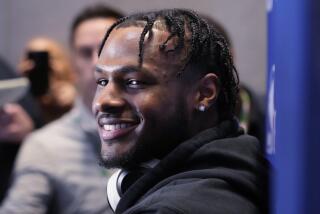Some Players Who Were Left Out of Draft Won’t Be Left in Cold
You could make a pretty good argument for NCAA success with a starting lineup of Charles Smith, Jeff Lebo, Lowell Hamilton, Tony Dawson and Melvin McCants, coupled with the likes of Jay Burson, Kenny Sanders, Andrew Gaze, Mouse McFadden and Leonard Taylor coming off the bench. But the NBA -- the domain of Magic, Air Jordan, Bird and Akeem -- isn’t State U., one reason why all those college stars are trying to hook on with a pro team after being passed over in Tuesday’s NBA draft.
In last year’s draft there undoubtedly would have been a place for each. Burson, a guard from Ohio State, was among the nation’s leading scorers before a late-season injury ended his collegiate career. Gaze led Seton Hall to the 1989 championship game with outside shooting reminiscent of Bird’s. Hamilton was a mainstay on Illinois’s Final Four squad. Dawson was part of Florida State’s rise to national prominence, and pivotmen Taylor and McCants, from the University of California and Purdue, were among the nation’s best rebounders.
But this year the draft went from three to two rounds, and a number of collegiate stars were left out in the cold. Some people familiar with their careers aren’t sure why.
“The NBA system isn’t infallible. There are kids who were drafted that are lesser players than some of the ones who weren’t,” said George Mason Coach Ernie Nestor, whose star, Sanders, wasn’t selected. “The NBA people are going to figure that out and then they’ll be out there recruiting players to come in. The shoe will be on the other foot for a change.”
Sanders is just one of 55 players in NCAA history to score 2,000 points and grab 1,000 rebounds. He averaged almost 24 points with 11 rebounds his senior year and led the Patriots to an NCAA tournament berth. Regarded as a 6-foot-5 inside player, however, many NBA executives were unsure whether Sanders can play along the perimeter in the pros, doubts that were exacerbated when he had a spotty performance in the NBA’s postseason camp in Portsmouth, Va.
“I spoke with him before the draft and I told him that, given the reduction in rounds, his chances of getting drafted weren’t great,” said Nestor. “I think that was clear when he wasn’t invited to the (June) camp in Chicago. The NBA asks about 64 players to come to that, so if they don’t include you, then it’s a good likelihood that you aren’t going to be picked.”
For any free agent, the process of finding a team begins with his agent contacting each of the 27 NBA clubs, notifying them that the player is available.
“A lot of the guys are better off not being drafted because now they have a choice instead of being forced to go to one particular club,” said Boston-based agent Bob Woolf. “You have to be aware of things like if a team has a roster full of guaranteed contracts because that wouldn’t do you any good. But the most important thing is to look carefully at each roster to determine what each one’s weaknesses are and if your guy fits in with them.
“It’s not entirely pie-in-the-sky. Some of these guys have legitimate shots but only with the club that’s best suited for them.”
Surprisingly, that chance could come with one of the league’s elite teams. In recent seasons a great deal of attention has been given to the “Great Eight” of the Los Angeles Lakers and the nine-man rotation of the 1989 champion Detroit Pistons. But that still leaves seven spots between the two, roster positions held by journeymen like Mark McNamara and disposable rookies like ex-Piston Michael Williams.
A four-year starter at point guard for Cleveland State, McFadden has already winnowed his options down to six NBA teams, with the help of his coach, Kevin Mackey.
“They all say they want you to come in but you have to figure out who’s sincerely interested. If it’s a position that they really need help at, you know they’re going to bring in three or four different guys and pick among them,” Mackey said. “Philadelphia has really impressed me though, and you look at the fact that Maurice Cheeks (the team’s current starting point guard) is 33 years old ...”
The 76ers aren’t the only team in need of help at the point, one reason why, as Nestor said, NBA teams find themselves acting like college recruiters trying to convince the unpicked collegians to attend their free-agent and summer-league camps.
“It seems like every team in the league has called here,” said Mackey. “It makes me wonder, if all these guys think Mouse is so good, why didn’t they pick him two nights ago?”
Although McFadden led Cleveland State to an NCAA tournament victory over Indiana his freshman year, holds the school record for career points and averaged 22.9 points with seven assists his senior season, that didn’t hold as much sway with the pros as his height. Listed at 6-1, McFadden is probably closer to 5-9.
“I know it gets old for coaches to say that their guy belongs in the NBA, but I think I’ve had some good experiences with small guards,” said Mackey, who coached a pair of diminutive pros, Michael Adams and John Bagley, during his days as an assistant at Boston College. “Look at Michael -- he wasn’t supposed to be able to play pro ball, he bounced around for three years until he found the right situation in Denver, and now he’s a star.”
More to Read
Go beyond the scoreboard
Get the latest on L.A.'s teams in the daily Sports Report newsletter.
You may occasionally receive promotional content from the Los Angeles Times.










